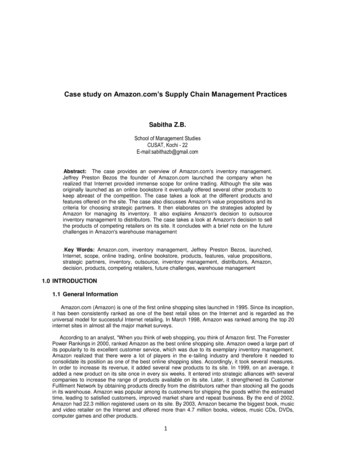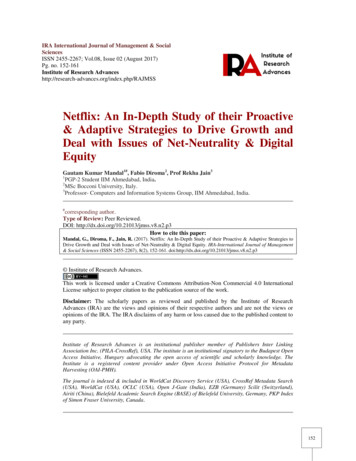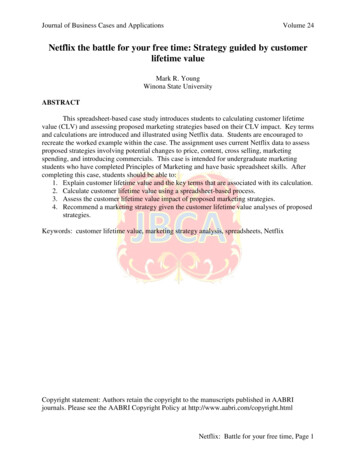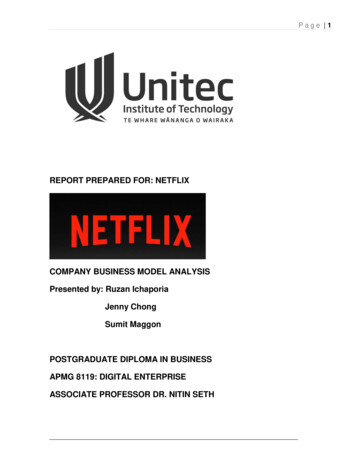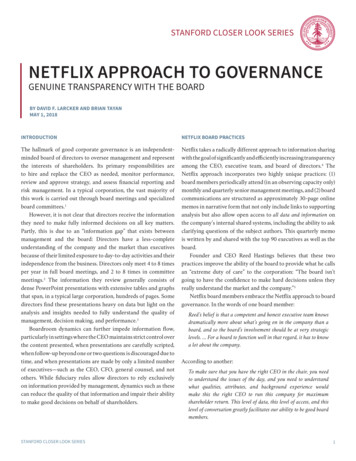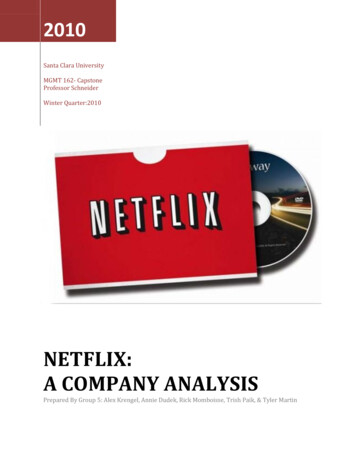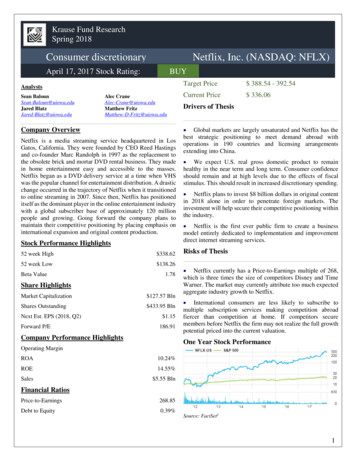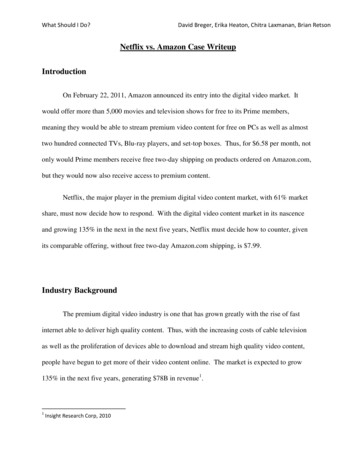
Transcription
What Should I Do?David Breger, Erika Heaton, Chitra Laxmanan, Brian RetsonNetflix vs. Amazon Case WriteupIntroductionOn February 22, 2011, Amazon announced its entry into the digital video market. Itwould offer more than 5,000 movies and television shows for free to its Prime members,meaning they would be able to stream premium video content for free on PCs as well as almosttwo hundred connected TVs, Blu-ray players, and set-top boxes. Thus, for 6.58 per month, notonly would Prime members receive free two-day shipping on products ordered on Amazon.com,but they would now also receive access to premium content.Netflix, the major player in the premium digital video content market, with 61% marketshare, must now decide how to respond. With the digital video content market in its nascenceand growing 135% in the next in the next five years, Netflix must decide how to counter, givenits comparable offering, without free two-day Amazon.com shipping, is 7.99.Industry BackgroundThe premium digital video industry is one that has grown greatly with the rise of fastinternet able to deliver high quality content. Thus, with the increasing costs of cable televisionas well as the proliferation of devices able to download and stream high quality video content,people have begun to get more of their video content online. The market is expected to grow135% in the next five years, generating 78B in revenue1.1Insight Research Corp, 2010
What Should I Do?David Breger, Erika Heaton, Chitra Laxmanan, Brian RetsonAs a result, a big industry has grown to try and capture this fast growing market. Apple,already selling download-to-own music online over iTunes, began to sell and rent video contentthrough the store. Netflix, originally in the offline DVD subscription space, began to focus moreand more of its efforts on an online video subscription service. Blockbuster also tried to copy itsdirect competitor with very little success. Amazon, primarily an offline product reseller, movedinto this space with an online video on demand offering similar to that of Apple. The contentowners also tried to capture some of this digital video market through the creation of Hulu, withboth an ad-supported as well as a subscription-based offering. And finally, the contentdeliverers, the cable companies, moved into this space with both offline as well as online videoon demand offerings.By February 2010, all of the different players had different offerings in an effort topredict how consumers purchase their online video content. Netflix became the market’sdominant player, with 61% market share, compared with 8% for Comcast and 4% each forDirecTV, Time Warner Cable, and Apple2.2NPD, 2011
What Should I Do?David Breger, Erika Heaton, Chitra Laxmanan, Brian RetsonComparison of Online Premium Digital Video Content Offerings3The PlayersThe Incumbent Dominant Market Leader - NetflixCompany Overview4Now with more than 20M subscribers, Netflix launched as an offline DVD subscriptionservice in 1999. At this time, a subscription movie and television service was a novel conceptand Internet speeds were generally not fast enough to handle high quality video. However,Netflix was an innovative company and realized that, in the future, videos would be consumed34Clicker, 2010All information from Netflix 10-K, 2010
What Should I Do?David Breger, Erika Heaton, Chitra Laxmanan, Brian Retsondigitally rather than on DVD. Thus, in 2007, Netflix launched a free unlimited streaming servicefor its subscribers, although initially with very limited content. Since then, online streaming hasbecome a more prevalent part of Netflix’s offering – over 60% of subscribers have streamed ashow or movie, and more than one third of new subscribers are signing up for the pure streamingplan. And at peak times Netflix subscribers in the U.S. drives more than 20% of peakdownstream Internet traffic5.The OfferingAlthough it had unlimited streaming since 2007, in November 2010, Netflix offered anunlimited streaming-only subscription for 7.99 a month, with the option to also get DVDs for 2 more and up; thus, all of Netflix’s plans currently offer unlimited streaming. Netflix offersthe largest, newest, and highest quality catalog of movies and television shows among the onlinesubscription services and continues to grow this. Furthermore, hundreds of consumer electronicsdevices offer Netflix, meaning consumers can not only watch video on their PCs, but also onconnected TVs, connected consoles, set-top boxes, Blu-ray players, and mobile devices. Netflixis in a unique position here compared to its competitors as it does not offer hardware, as doApple, Sony, and Amazon, meaning it can be a neutral party on multiple types of devices.The Incoming Rival - Amazon6Company Overview56Sandvine, 2010All information from Amazon 10-K, 2010
What Should I Do?David Breger, Erika Heaton, Chitra Laxmanan, Brian RetsonAmazon has become the market leader in online commerce since launching in 1995.Amazon started as an online bookstore, but soon diversified into numerous other areas. Amazonquickly expanded by making online retail inexpensive and easy, through price leadership as wellas free shipping. Amazon had solely provided commerce for physical goods until launchingAmazon Unbox (now Amazon Instant Video) in 2006. With this move, Amazon moved into thedigital content commerce space with both music and video, and it further moved into sellingcontent with the launch of the Kindle in 2007.The OfferingSince 2006, Amazon has had an online video on demand service. However, on February22, 2011, Amazon moved into the digital video subscription place, where Netflix is the dominantmarket player. While users are not paying directly for the video subscription service, unlimitedInstant Videos are available for free for Amazon Prime customers. Amazon Prime is a servicecustomers pay 79 a year for free two-day shipping; now, Prime customers will also receive freeonline videos, meaning it is cheaper at 6.58 per month than Netflix’s comparable unlimitedstreaming option. At this point, much less content is available on Prime Instant Video thanNetflix’s comparable offering. However, as Amazon’s video on demand service has a muchlarger library than even that of Netflix, it is likely that Amazon will be able to expand the contentavailable for Prime Instant Video. Finally, as with Netflix, Instant Video is available on not onlythe PC, but also on hundreds of consumer electronics devices.The Game
What Should I Do?David Breger, Erika Heaton, Chitra Laxmanan, Brian RetsonAssumptionsFor the purposes of our analysis, we are making the following assumptions: The incumbent (Netflix) presently has all of the digital video subscription market. This isan exaggeration of reality since there are several other players, but Netflix is currently theclear-cut market leader. Amazon is seeking to be a player in the streaming video market and is not just usingstreaming video as an extra benefit for Amazon Prime customers.o For the calculations of our payouts, we are only including revenue from theAmazon Prime subscription fee (i.e., we are not including potential additionalrevenue if customers buy more due to free Amazon Prime shipping). The streaming video market will be 1B / year at the 7.99 price point. (This wascalculated by assuming that 60% of Netflix subscribers stream video.) Customers are sensitive to price, and a 1 decrease in price will yield a 10% increase indemand. In our games, “accommodate” means to price at 7.99 / month, and “fight” means toprice at 4.99 / month.The Simultaneous GameIn this version of the game, now that Amazon has already decided to enter the market,both Amazon and Netflix will make their decisions about whether to accommodate or fight inunison. This situation could arise if both sides need to make preparations for marketingcampaigns before knowing what the other will do. We assumed that 80% of customers will go to
What Should I Do?David Breger, Erika Heaton, Chitra Laxmanan, Brian Retsonthe subscription service with the lowest price, and 20% would remain loyal due to switchingcosts or brand loyalty.Amazon has already decided to enter because they realize that they will be profitableregardless of the outcome of the game. The simultaneous game model is a prisoner’s dilemma,and the equilibrium will be reached with both Amazon and Netflix choosing to fight and splittingthe market.The Sequential GameInstead of a simultaneous game, a sequential game might occur in the scenario in whichcustomer switching costs are assumed to be extremely high. Amazon will want to aggressivelypursue customers before they get locked into long-term contracts with Netflix, whereas Netflixwill want the exact opposite scenario. Therefore, each company will seek first-mover advantage,
What Should I Do?David Breger, Erika Heaton, Chitra Laxmanan, Brian Retsonand the game will move towards a sequential game, with the company that moves first getting asmall amount of additional revenue. The example below illustrates the outcome if Netflix movesfirst and is able to reach customers first, thus generating a slightly higher payout for Netflix.Alternatively, Amazon can change they game if it can successfully maintain a perceptionthat it is only in the streaming video market as a way of providing an additional service toAmazon Prime customers. This is a “puppy dog” strategy where Amazon seeks to not makeenough noise in the market to cause a reaction from the incumbent. However, making thisperception credible will be a great challenge for Amazon, especially given the large projectedgrowth and profit margins of the market.
What Should I Do?David Breger, Erika Heaton, Chitra Laxmanan, Brian RetsonHow to Change the GameBoth companies have the opportunity to change the game and influence potential (and/orperceived) payouts.Netflix has the opportunity to change the game and alter the potential payouts forAmazon by moving first and increasing customer loyalty. There are many ways in this can beaccomplished, both through incentives and punishments. Netflix can have customers to committo a long-term contract with a large fee for early termination. It can either require a contract formembership, or it can offer financial incentives to those who choose to enter into a contract. Inaddition, Netflix can seek to differentiate its service offering by providing unique programming,superb customer service, etc. For example, if Netflix is able to offer Disney movies through anexclusive contract, this might cause some customers to be more willing to stay with Netflix evenif it costs more than Amazon. Netflix can also seek to differentiate based on devices. If it is ableto offer its service on devices where Amazon is unable to offer service (e.g., the iPad), this canalso serve as a means of increasing customer loyalty and decreasing incentives to defect.Increasing customer loyalty would deter customers from switching to Amazon, and thuswould limit Amazon’s market penetration and profits. For these payoffs, we assumed that only65% of customers will go to the lowest price and 35% will remain brand loyal. In this scenario, anew equilibrium is generated for the accommodate / accommodate strategy.
What Should I Do?David Breger, Erika Heaton, Chitra Laxmanan, Brian RetsonThe increased loyalty effect would be strongest in the short-term, and customers wouldhave more options over time as their contracts expire. Therefore, Netflix will need to providelong-term service differentiation as well if it hopes to not lose major market share to Amazon.ConclusionBoth Amazon and Netflix have a lot to gain in the digital video subscription market.However, it is against the best interests of both sides to engage in a price war where consumersview the service as a commodity and simply go with the lowest price. If both sides seek toincrease loyalty and/or differentiate their service, the industry can achieve cooperation and avoida prisoner’s dilemma situation. If successful, this will mean higher profits for both companies.
plan. And at peak times Netflix subscribers in the U.S. drives more than 20% of peak downstream Internet traffic5. The Offering Although it had unlimited streaming since 2007, in November 2010, Netflix offered an unlimited streaming-only subscription for 7.99 a month, with the option to also get DVDs for 2 more and up; thus, all of Netflix’s plans currently offer unlimited streaming .

